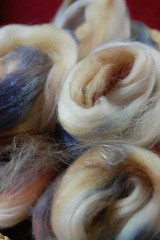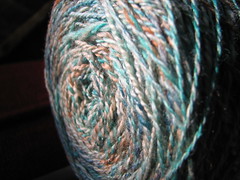Fiber Preparation
So … you’ve got your fleece, and you’ve carefully cleaned it (so as not to turn it into felt) … now what? You need to get it ready to spin, which comes with its own set of fun words..

- Cards: You know those dog brushes that are mostly flat but have hundreds of wires to catch loose fur. Imagine them bigger and maybe a little finer, and you’ve got wool cards. These are used to separate the fibers in locks of wool and get them roughly pointing in the same direction. Also used for blending different fibers, different colors together.
- Drum Carder: The mechanical version–basically a big cylinder covered in those fine wires. All the person needs to do is feed in the fiber and turn the handle. Much more practical (though much bigger) than a set of hand cards.
- Charge: The act of putting wool ON the cards.
- Rolag: The cute little roll of combed wool you get when you remove the wool from the cards–made by literally rolling the combed fiber off the card. These are usually used for spinning woolen yarn. (By which I mean the spinning technique, not the fiber, but that’s another vocabulary list.)
- Batt: If, instead of making rolags, you peeled your fiber off (ever so carefully) so that you had one, flat piece of fluffy wool … That’s a batt. It’s also what you get off your drum carder.
- Combs: The rather vicious-looking implements used to prepare wool for spinning worsted yarn. They come in pairs and while they come in different sizes, the teeth are usually at least 4″ long and come in multiple rows. Usually, one comb is clamped to a table and the other is used to comb through the fiber, removing similar length. You do NOT want to get in the way of wool combs when they’re in action and, if you ever plan on writing a murder mystery on a sheep farm? There’s your murder weapon.
- Load: The act of putting wool onto the combs.
- Diz: A disk with a small hole, used for pulling combed fiber through so that you end up with a long strand of totally aligned fibers, ready to spin. (And, is this not a wonderful Scrabble word?)
- Sliver: That narrow strand of fiber you just pulled through your diz? That’s called Sliver (pronounced SLY-ver, a different pronunciation than what you’d call the small piece of cake you eat just “to be polite”).
- Roving: If you take that sliver and add just a little twist along the length of it to hold it together? That’s roving. Generally speaking, most commercially-purchased spinning fiber comes as roving. One long, long, long strand of unspun fiber, just waiting to be turned into yarn.
- Top: The perfectly aligned fiber that comes from combs.
The Actual Spinning
I’ve explained the parts of the wheel, I’ve described where fiber comes from and how you get it ready to spin … now, the spinning itself. (Again, from a vocabulary point of view.) Finally–the fun part!

- Saxony Wheel: This describes a type of spinning wheel, where the drive wheel is placed horizontally to the bobbin and flyer assembly. Just about every picture you’ve ever seen of Sleeping Beauty shows one of these style of wheels.
- Castle Wheel: These wheels work the same as the Saxonys, but are designed vertically. They take up a lot less floor space. Some people think these are a modern invention, but in fact, they go back to when spinning was a cottage industry and, well, cottagers just didn’t have a lot of floor space!
- Charkha Wheel: Invented by Gandhi, who was determined that spinning could provide sustainable skills for India (not to mention being ideal for meditating). The Charkha is designed to fold in half for easy portability, and is best for spinning fine, short fibers like cotton, angora, or dog hair. (Yes, I said dog hair.)
- Draft: So, those large pieces of ready-to-spin fiber you’ve laboriously prepared (or, like me, bought)? Before you can turn them into yarn, you need to spread the fibers out so that you end up with, you know, thread, instead of rope. This process is known as drafting–sliding the fibers along so that the twist only affects a few fibers at a time instead of the whole batch you’re holding in your hand.
- Drafting Triangle: That magical space between the last part of spun yarn and the completely undrafted fibers in your hand … so named because the fibers fan out from the twist out to the unspun fibers, forming a triangle.
- Leader: The starter thread already attached to the bobbin that you attach your unspun yarn to. This is an absolute requirement for spinning wheel spinning, but optional for a spindle.
- Worsted: Yarn spun tightly with completely aligned fibers, making yarn that is strong and relatively smooth and dense. Since this is tougher yarn, this is what you’d use to knit hard-wearing socks, or sturdy sweaters. Or the strong stuff you use to string a loom.
- Woolen: Yarn spun loosely, usually from a rolag, so that the fibers spiral around a core of air, making it warmer and lighter, but also a fuzzier yarn than worsted. Garments made of this yarn usually pill easily, but using it as the weft of a woven blanket makes for a nice, soft blanket.
- Short Draw: Used for spinning worsted yarn, by pulling small bits of fiber at a time into the drafting triangle. Great for beginners, who refer to this as “inch-worming” because you spin one, single inch at a time. Great for control and evenly spun yarn.
- Long Draw: Used for spinning woolen yarn, this is dramatic and fun to watch–this allows the twist itself to draft and pull the fiber into the yarn, so the spinner, while treadling, pulls one arm allllll the way back, while the wheel pulls fiber into the twist. It’s tricky to learn, fun to do, and impressive as anything to watch.
- Cabled: I explained Singles and how twisting two or more of them together made for plied yarn? Well, if you take two or more strands of the plied yarn and twist them together in the reverse direction from which they were plied, you end up with a yarn that looks almost braided and oh, so cool to look at. This is cabled yarn, and it’s even stronger than regular, plied yarn … think about the cables that make up suspension bridges .. those are cabled, too, all made up from single wires grouped into small groups, then bigger, and bigger, groups until they’re exponentially stronger than they could ever be on their own.
- Boucle: Yarn that is plied together under different tensions, so that instead of winding together evenly, one wraps itself around the other, adding texture.
 Would it interest you to know that spinning has had a resurgence in popularity, lately? That there are people right now making livings from making spinning wheels and spindles? And not just any, old spinning wheels and spindles. Check out the Golding website and look at the workmanship in his woodwork. They’re masterpieces. (Expensive masterpieces.) Or, the Journey Wheels which are like full-size Charkhas and fold in half for travelling. They are some of the most amazing things I’ve ever seen, and made solely by one person here in the USA. Not to mention some of the other companies that are making beautiful, creative spinning wheels that are in high demand by spinners all over the world. Of my three spinning wheels, one (by Gord Lendrum) is from Canada, one (my Journey Wheel) is from New England, and one (the Majacraft I bought for my 40th birthday) is from New Zealand.
Would it interest you to know that spinning has had a resurgence in popularity, lately? That there are people right now making livings from making spinning wheels and spindles? And not just any, old spinning wheels and spindles. Check out the Golding website and look at the workmanship in his woodwork. They’re masterpieces. (Expensive masterpieces.) Or, the Journey Wheels which are like full-size Charkhas and fold in half for travelling. They are some of the most amazing things I’ve ever seen, and made solely by one person here in the USA. Not to mention some of the other companies that are making beautiful, creative spinning wheels that are in high demand by spinners all over the world. Of my three spinning wheels, one (by Gord Lendrum) is from Canada, one (my Journey Wheel) is from New England, and one (the Majacraft I bought for my 40th birthday) is from New Zealand.
In other words, spinning’s not just for renaissance festivals and historical reenactments, anymore.

Oops–meant to put some links into that last paragraph!
Golding (I have a couple spindles, but can’t afford his wheels: http://www.goldingfibertools.com/
Journey Wheels: http://www.journeywheel.com/content/section/7/106/
Majacraft (which is what my favorite wheel is): http://www.majacraft.co.nz/
Lendrum: http://www.lendrum.ca/
Heck, just look at the list of available wheels to buy, brand new: http://www.woolery.com/Pages/selectwheel.html
–Deb’s last blog post..Spinning Words 3–The Spinning
Deb, I never realized how much there is to know about spinning. Even though I don’t practice the art, your posts have given me a much greater appreciation of the work that goes into making the finished materials. Thank you!
Brad Shorr’s last blog post..Client Blog Makes the Search Engine Marketing BIGLIST
Luckily, you can buy wool ready to spin and an inexpensive spindle, and be spinning in a matter of moments. It’s when you have to start from scratch that it becomes a TON of work! It’s like the difference between buying a house that needs paint and wallpaper and maybe some new light fixtures as opposed to getting a house by heading to the forest with an ax on your shoulder!
The words are fun though, huh?
–Deb’s last blog post..Spinning Words 3–The Spinning
“Diz” and “boucle” are my favorites in these two lists. You know, I’ve always wanted to go to a Ren Faire. There used to be a really big one that came to a nearby city every year. I think it’s several hours away now. The strange thing is that a Ren Faire is right up my alley and I can’t figure out why I never went.
Melissa Donovan’s last blog post..Plot vs. Character: Fiction Writing
My favorite? YARN! Or, well, it’s my favorite THING about spinning, anyway…
Although, did I mention that spinning is also very relaxing and meditative? How often do you get to be relaxed AND productive at the same time?
–Deb’s last blog post..Spinning Words 3–The Spinning
I was wondering if you knew where I could obtain parts for a charkha? I wish to build one, and there are a few parts that would be difficult to make by hand.
Thanks Leah
Pingback: Highlights from 2009